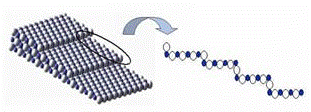Chemistry, Department of: Faculty Series

Marjorie A. Langell Publications
Document Type
Article
Date of this Version
3-2007
Citation
Applied Surface Science (March 2007) 253(10): 4,782–4,791
doi: 10.1016/j.apsusc.2006.10.044
Abstract
The surface composition and chemical environment of LiCoO2, hexagonal LiNiO2, cubic LiNiO2, and the mixed transition metal oxide LiNi0.5Co0.5O2 have been determined by Auger electron and X-ray photoelectron spectroscopies. While the LiCoO2 surface properties can easily be extrapolated from bulk composition, the nickel-containing materials are less straightforward. Their surface concentration tends to be depleted in lithium relative to that of the bulk and shows an atypical chemical environment for the constituent elements. The Ni 2p XPS photoemission suggests a near “ NiO-like” selvedge through the XPS binding energies and satellite structure which are essentially identical to that of NiO; the spectrum appears fairly insensitive to lithium concentration. Although there is little evidence for higher binding energy Ni3+ species or for an electron poor Ni2.δ+derived band structure in the XPS, the lattice oxygen is very electron-rich and yields among the lowest binding energies reported for a transition metal oxide. The nickel-containing lithium oxide selvedge is thus not simply “NiO” and the surface lithium cations have a measurable effect on the electronic structure even in their more highly depleted levels. This is explained in the context of the charge-transfer model of the oxide band structure.


Comments
Copyright © 2006, Elsevier. Used by permission